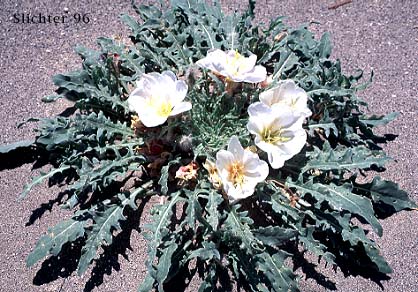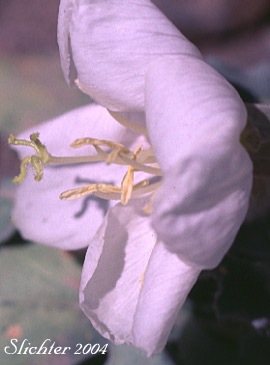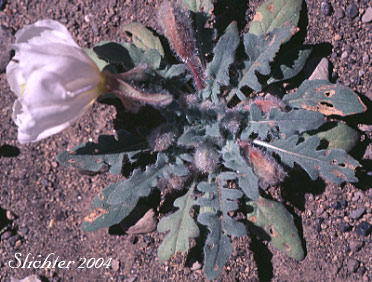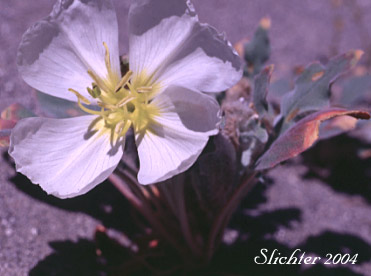

 The
photo at right shows a close-up of the flower of hairy evening-primrose as seen
at Fort Rock State Park in south-central Oregon......July 19, 1998. Note the style
exserted beyond the petals with its 4-lobed stigma.
The
photo at right shows a close-up of the flower of hairy evening-primrose as seen
at Fort Rock State Park in south-central Oregon......July 19, 1998. Note the style
exserted beyond the petals with its 4-lobed stigma.
Hairy evening-primrose is an annual to biennial of the intermountain, desert west which grows up to 30 cm tall.The herbage varies from glabrous to short-hairy. The short stems often have a whitish outer covering which eventually exfoliates. The leaves are mostly basal, or near the tips of the many spreading branches. Individual leaves are 3 to 7 cm long, oblanceolate to obovate in shape, with subentire to sinuate-pinnatifid margins. The leaf narrows to slender petioles that are about as long as the leaf blade.
The nocturnal flowers are numerous, sessile, and with the buds nodding. The sepals are about 10 to 30 mm long and purplish colored. They are often covered with long, straight or curly hairs. The sepals are joined in bud, but each is separated in bloom. The four petals are 20 to 40 mm long, rounded to obcordate in shape, and white at first, before fading to a purplish color. The stamens are 2/3 the length of the petals, with the stamens 5-10 mm long. The style is exerted about 1.3-2.5 cm beyond the petals with the stigma at its tip 4-lobed, the lobes spreading.
Variety piperi is found in south-central to south-eastern Oregon and south into northeastern California and western Nevada. It has sepals that are densely long, curly and hairy, measuring from 1.5-3 mm long. The petals range from 1.5-3 cm long. The upper leaves are noticeably pinnatifid and plants may appear not to have stems. Typically found between the elevations of 850-1800 meters.
Hairy evening-primrose typically is found on sandy soil.
Hairy evening-primrose is found across much of the deserts of the western United States. It is found from Crook County, Oregon southward to southern California, and eastward through southeast Oregon to Utah and Arizona.

